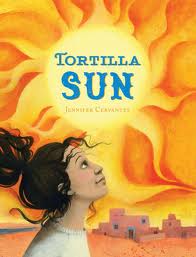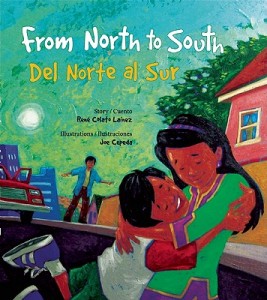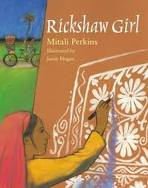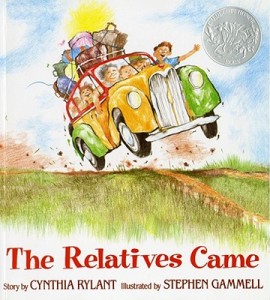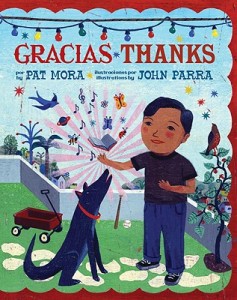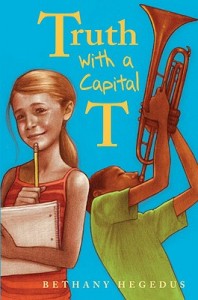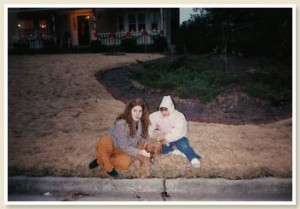The holiday of lights is here
Good friends and happiness to share
Sweets with honey for us to eat
Candles to light and friends to greetexcerpt from ” Ocho Candelikas,” a Hanukkah song of the Sephardic Jewish tradition
In honor of Hanukkah, which begins in just a few days, the ReaderKidZ have collected a few favorites to add to your holiday reading list. Some are light-hearted, others, more serious. We hope you’ll find a new treasure among them. Enjoy.
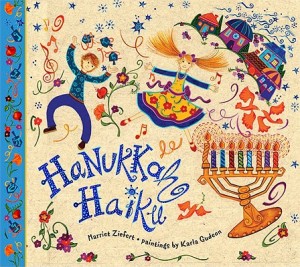 HANUKKAH HAIKU by Harriet Ziefert, paintings by Karla Gudeon
HANUKKAH HAIKU by Harriet Ziefert, paintings by Karla Gudeon
Hanukkah Haiku is stunning, not only for the bright colorful art and overall book design, but also for the beautiful text, one poem to celebrate each new evening’s lit candle. The final double-page spread features some of the Hebrew and English blessings recited while lighting the candles.
THE CHANUKKAH GUEST by Eric A. Kimmel, illustrated by Giora Carmi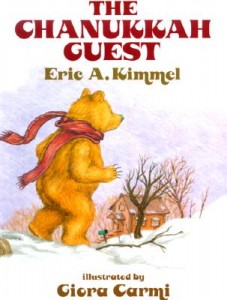
As 97-year old Bubba Brayna prepares the last potato latke for her soon-to-arrive guests, a surprise visitor knocks – or rather, thumps – on her door. Because she’s getting on in years and her eyes and ears are not as sharp as they used to be, Bubba Brayna doesn’t realize that the guest who lumbers into her home grumbling and rrrumphing is not the rabbi she expected, but instead Old Bear, who’d followed the delicious smells to Bubba Brayna’s cozy home.
This book, published over ten years ago, is still a favorite classroom read-aloud each year.
ONE YELLOW DAFFODIL: A Hanukkah Story by David A. Adler , illustrated by Lloyd Bloom
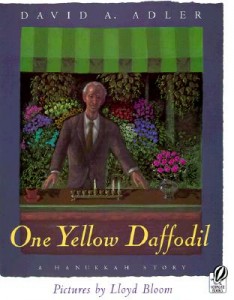 A tender story about an older man, Morris, who rediscovers the blessing of friendship when two children, Ilana and Jonathan, invite him to spend the second evening of Hanukkah with their family.
A tender story about an older man, Morris, who rediscovers the blessing of friendship when two children, Ilana and Jonathan, invite him to spend the second evening of Hanukkah with their family.
While there, Morris begins to think back to the Hanukkahs he celebrated as a small boy in Poland. When he returns home later that evening, Morris searches his closet for the old box that holds a few items from his childhood: a metal cup, a torn shirt, a child’s hat, and an old menorah. He recalls an earlier time, years previous, when a “small yellow flower, a daffodil” bloomed just outside his barracks. Under the circumstances in which Morris lived at that time, the daffodil became for him a symbol of hope.
Ilana and Jonathan’s invitation to celebrate Hanukkah with their family sparks, as the daffodil had so many years before, a glimmer of hope as Morris, once again, rekindles some of the fond memories of his childhood.
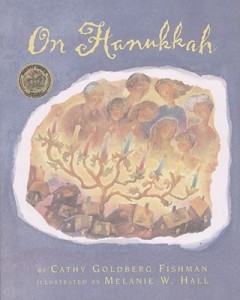 ON HANUKKAH by Cathy Goldberg Fishman, illustrated by Melanie W. Hall
ON HANUKKAH by Cathy Goldberg Fishman, illustrated by Melanie W. Hall
“It is the evening before the twenty-fifth day of the Hebrew month of Kislev. It is time for the eight-day Jewish holiday of Hanukkah, the Festival of Lights.” So begins the account of one family’s Hanukkah celebration.
Seamlessly weaving historical background into the narrative, Fishman leaves readers feeling very much a part of this family’s celebrations. The warmth of the holiday, the joy of being together, and the inspirational significance of this historic event will resonate with readers.
HANUKKAH AT VALLEY FORGE by Stephen Krensky, illustrated by Greg Harlin
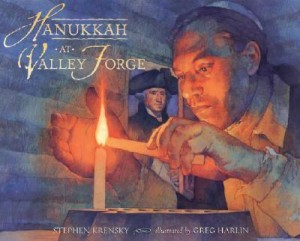 From the Author’s Note: “This story of George Washington and Hanukkah is based on facts…It is know that in December 1778, Washington had lunch at the home of Michael Hart, a Jewish merchant in Easton, Pennsylvania… when Hart began to explain the holiday to the general, Washington… told the merchant and his family of meeting the Polish soldier at Valley Forge the year before.
From the Author’s Note: “This story of George Washington and Hanukkah is based on facts…It is know that in December 1778, Washington had lunch at the home of Michael Hart, a Jewish merchant in Easton, Pennsylvania… when Hart began to explain the holiday to the general, Washington… told the merchant and his family of meeting the Polish soldier at Valley Forge the year before.
HANUKKAH AT VALLEY FORGE is the story of this seemingly small historical anecdote, imagined and fictionalized by author, Stephen Krensky, into events as they might have taken place. Powerfully told, it presents the story of the Maccabees and the candles that blazed for eight days in a new and engaging way.
THE HANUKKAH MICE by Steven Kroll, illustrated by Michelle Shapiro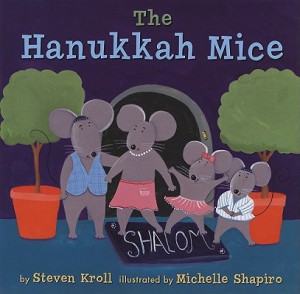
While the Mr. Silman lifts the shammes, says the prayers, and lights the first candle of Hanukkah, a family of kind mice watch and wait nearby. As young Rachel Silman admires her first Hanukkah gift, the mice share her excitement – the dollhouse is just their size!
Each day of Hanukkah brings Rachel another small treasure for the dollhouse – a wingback chair with a matching stool, little plates just right for tiny latkes, and more. As Rachel opens each new gift, the mice family delights to find that they, too, are mysteriously being included in the Hanukkah festivities.
Younger readers will especially enjoy the bright, lively illustrations and the delightful story that accompany them.








